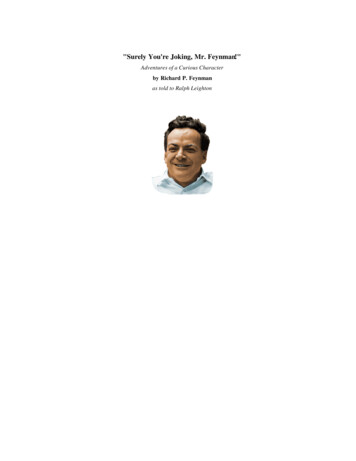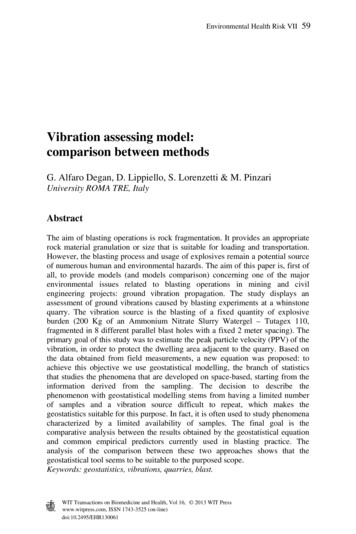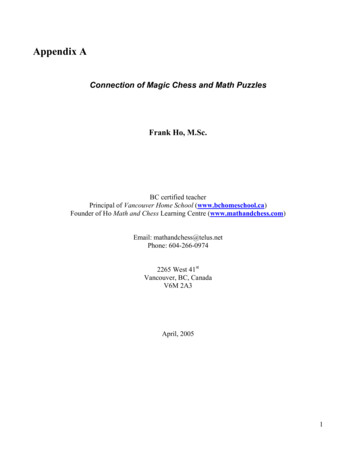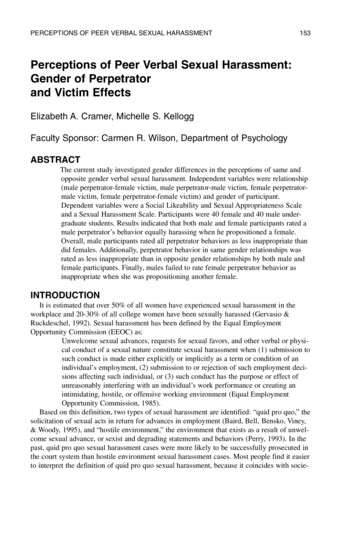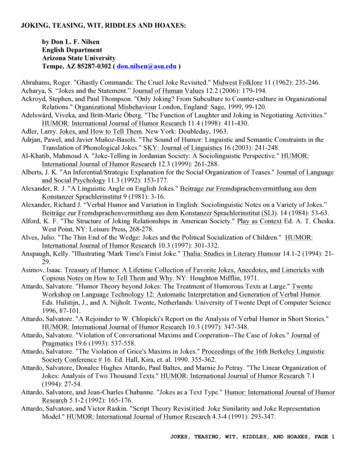
Transcription
JOKING, TEASING, WIT, RIDDLES AND HOAXES:by Don L. F. NilsenEnglish DepartmentArizona State UniversityTempe, AZ 85287-0302 ( don.nilsen@asu.edu )Abrahams, Roger. "Ghastly Commands: The Cruel Joke Revisited." Midwest Folklore 11 (1962): 235-246.Acharya, S. “Jokes and the Statement.” Journal of Human Values 12.2 (2006): 179-194.Ackroyd, Stephen, and Paul Thompson. "Only Joking? From Subculture to Counter-culture in OrganizationalRelations." Organizational Misbehaviour London, England: Sage, 1999, 99-120.Adelswärd, Viveka, and Britt-Marie Öberg. "The Function of Laughter and Joking in Negotiating Activities."HUMOR: International Journal of Humor Research 11.4 (1998): 411-430.Adler, Larry. Jokes, and How to Tell Them. New York: Doubleday, 1963.Adrjan, Pawel, and Javier Muñoz-Basols. "The Sound of Humor: Linguistic and Semantic Constraints in theTranslation of Phonological Jokes." SKY: Journal of Linguistics 16 (2003): 241-248.Al-Khatib, Mahmoud A. "Joke-Telling in Jordanian Society: A Sociolinguistic Perspective." HUMOR:International Journal of Humor Research 12.3 (1999): 261-288.Alberts, J. K. "An Inferential/Strategic Explanation for the Social Organization of Teases." Journal of Languageand Social Psychology 11.3 (1992): 153-177.Alexander, R. J. "A Linguistic Angle on English Jokes." Beitrage zur Fremdsprachenvermittlung aus demKonstanzer Sprachlerinstitut 9 (1981): 3-16.Alexander, Richard J. “Verbal Humor and Variation in English: Sociolinguistic Notes on a Variety of Jokes.”Beiträge zur Fremdsprachenvermittlung aus dem Konstanzer Sprachlerinstitut (SLI). 14 (1984): 53-63.Alford, K. F. "The Structure of Joking Relationships in American Society." Play as Context Ed. A. T. Cheska.West Point, NY: Leisure Press, 268-278.Alves, Julio. "The Thin End of the Wedge: Jokes and the Political Socialization of Children." HUMOR:International Journal of Humor Research 10.3 (1997): 301-332.Anspaugh, Kelly. "Illustrating 'Mark Time's Finist Joke." Thalia: Studies in Literary Humour 14.1-2 (1994): 2129.Asimov, Isaac. Treasury of Humor: A Lifetime Collection of Favorite Jokes, Anecdotes, and Limericks withCopious Notes on How to Tell Them and Why. NY: Houghton Mifflin, 1971.Attardo, Salvatore. "Humor Theory beyond Jokes: The Treatment of Humorous Texts at Large." TwenteWorkshop on Language Technology 12: Automatic Interpretation and Generation of Verbal Humor.Eds. Hulstijn, J., and A. Nijholt. Twente, Netherlands: University of Twente Dept of Computer Science1996, 87-101.Attardo, Salvatore. "A Rejoinder to W. Chlopicki's Report on the Analysis of Verbal Humor in Short Stories."HUMOR: International Journal of Humor Research 10.3 (1997): 347-348.Attardo, Salvatore. "Violation of Conversational Maxims and Cooperation--The Case of Jokes." Journal ofPragmatics 19.6 (1993): 537-558.Attardo, Salvatore. "The Violation of Grice's Maxims in Jokes." Proceedings of the 16th Berkeley LinguisticSociety Conference # 16. Ed. Hall, Kira, et. al. 1990. 355-362.Attardo, Salvatore, Donalee Hughes Attardo, Paul Baltes, and Marnie Jo Petray. "The Linear Organization ofJokes: Analysis of Two Thousand Texts." HUMOR: International Journal of Humor Research 7.1(1994): 27-54.Attardo, Salvatore, and Jean-Charles Chabanne. "Jokes as a Text Type." Humor: International Journal of HumorResearch 5.1-2 (1992): 165-176.Attardo, Salvatore, and Victor Raskin. "Script Theory Revis(it)ed: Joke Similarity and Joke RepresentationModel." HUMOR: International Journal of Humor Research 4.3-4 (1991): 293-347.JOKES, TEASING, WIT, RIDDLES, AND HOAXES, PAGE 1
Austin, James C. "Seeing the Elephant Again: P. T. Barnum and the American Art of Hoax." Thalia: Studies inLiterary Humor 4.1 (1981): 14-18.Bainy, Moses. "The Humour in the Joke." Why Do We Laugh and Cry? West Ryde, Australia: SunlightPublications, 1993, 78-121.Baker, Ronald L. Jokelore: Humorous Folktales from Indiana. Bloomington, Indiana Univ Press, 1986.Banc, C., and A. Dundes. First Prize: Fifteen Years!: An Annotated Collection of Romanian Political Jokes.Rutherford, NJ: Fairleigh Dickinson Univ Press, 1986.Barrick, Mac E. "The Helen Keller Joke Cycle." The Humor Prism in Twentieth-Century America. Ed. JosephBoskin, Detroit, MI: Wayne State University Press, 1997, 195-207.Barrick, Mac E. "Racial Riddles and the Polack Joke." The Humor Prism in Twentieth-Century America. Ed.Joseph Boskin, Detroit, MI: Wayne State University Press, 1997, 208-224.Basso, Keith. "Joking Imitations of Anglo-Americans: Interpretive Functions." Portraits of "The Whiteman".London, England: Cambridge University Press, 1979, 36-64.Bennett, Gillian. "'God I Love This Place!" The Workplace as Presxented in Photocopied Joke-Sheets: A VisualDisplay." Spoken in Gest. Ed. Gillian Bennett. Sheffield, England: Sheffield Academic Press, 1991.179-198.Benton, Gregor. "The Origins of the Political Joke." Humour in Society: Resistance and Control. Eds. ChrisPowell and George Paton. NY: St. Martin's, 1988, 33-55.Berger, Arthur Asa. "Anatomy of a Joke." An Anatomy of Humor. New Brunswick, NJ: Transaction, 1993, 5761.Berger, Arthur Asa. "Anatomy of the Joke." Journal of Communication 26.3 (1976): 113-115.Berger, Arthur Asa. The Genius of the Jewish Joke. Northvale: Jason Aronson, Inc, 1997.Berger, Arthur Asa. Blind Men and Elephants. New Brunswick, NJ: Transaction, 1995.Berger, Arthur Asa. "Laughing Matter/The Anatomy of a Joke." Journal of Communications (Summer, 1976):Berger, Arthur Asa. "What's in a Joke? A Micro-Analysis." Elementa 1 (1994): 321-330.Bergman, Merrie. "How Many Feminists Does It Take To Make a Joke? Sexist Humor and What's Wrong withIt." Hypatia 1.1 (1986): 63-82.Berk, Ronald, and Joy P. Nanda. "Effects of Jocular Instructional Methods in Attitudes, Anxiety, andAchievement in Statistics Courses." HUMOR: International Journal of Humor Research 11.4 (1998):383-410.Bermaint, Chaim. What's the Joke? London, England: Weidenfeld and Nicolson, 1986.Bernard, H. Russell, and J. S. Pedraza, eds. "Otomi Parables, Folktales, and Jokes." International Journal ofAmerican Linguistics Native American Texts Series 1.2, Chicago, IL: University of Chicago Press,1976.Bhattacharya, Baidik. “Jokes Apart.” Interventions: International Journal of Postcolonial Studies 8.2 (2006):276-294.Bing, Janet. "Lesbian Jokes: A Reply to Christie Davies." HUMOR: International Journal of Humor Research17.3 (2004): 323-328.Borges, Marilyn, Patricia Barrett, and Janet Fox. "Humor Ratings of Sex-Stereotyped Jokes as a Function ofGender of Actor and Gender of Rater." Psychological Reports 47 (1980): 1135-1138.Bowen, Barbara C. ed. One Hundred Renaissance Jokes. Birmingham, AL: Summa, 1988.Bradney, P. "The Joking Relationship in Industry." Human Relations. 10.2 (1957): 179-187.Bradshaw, John. "Verbal Jokes as De-Transformed Utterances and as Speech Acts." It's a Funny Thing,Humour. Eds. Antony Chapman and Hugh Foot. NY: Pergamon, 1977, 61-64.Brandes, Stanley. “Jewish American Dialect Jokes and Jewish-American Identity.” Jewish Social Studies 45(1983): 233-240.Bremmer, Jan. "Jokes, Jokers and Jokebooks in Ancient Greek Culture." A Cultural History of Humour: FromAntiquity to the Present Day. Eds. Bremmer, Jan, and Herman Roodenburg. Cambridge, England: PolityPress, 1997, 11-28.JOKES, TEASING, WIT, RIDDLES, AND HOAXES, PAGE 2
Bronner, Simon J. "Political Suicide: The Budd Dwyer Joke Cycle and the Humor of Disaster." MidwesternFolklore 14 (1988): 81-89.Bronner, Simon J. "What's Grosser than Gross? New Sick Joke Cycles." Midwestern Journal of Language andFolklore 11 (1985): 39-49.Brown, Judy. The Funny Pages New York, NY: Andrews McMeel, 2002.Brown, Judy. Joke Soup: 1,217 of the Funniest Jokes from the Best Comedians. New York, NY: AndrewsMcMeel, 1998.Brown, Judy. Joke Stew New York, NY: Andrews McMeel, 2000.Brown, S. K. “Political Realities and Cultural Specificities in Contemporary Macedonian Jokes.” WesternFolklore 54 (1995): 197-211.Brunvand, Jan Harold. "The Study of Contemporary Folklore: Jokes." Fabula 13 (1972) 1-19.Bryant, Jennings, and Timothy P. Meyer. "A Developmental Analysis of Children's Favourite Jokes." It's aFunny Thing, Humour. Eds. Antony Chapman and Hugh Foot. NY: Pergamon, 1977, 223-24.Bubel, Claudia, and Alice Spitz. “One of the Last Vestiges of Gender Bias: The Characterization of Womenthrough the Telling of Dirty Jokes in Ally McBeal.” HUMOR: International Journal of Humor Research19.1 (2006): 27-52.Buffery, Anthony W. H. "Funny Ha Ha or Funny Peculiar." It's a Funny Thing, Humour. Eds. Antony Chapmanand Hugh Foot. NY: Pergamon, 1977, 399-402.Buhle, Paul, ed. Labor's Joke Book. St. Louis, MO: W. D. Press, 1985.Bunzel, Reed E. "Station Stunts Tread Fine Line between Humor and Hoax." Broadcasting 120.14 (1991): 5455.Burnand, Gordon. "Teasing and Joking in Isolated Societies." It's a Funny Thing, Humour. Eds. AntonyChapman and Hugh Foot. NY: Pergamon, 1977, 437-38.Burns, Thomas A. Doint the Wash--An Expressive Culture and Personality Study of a Joke and its Tellers. NY:Norwood, 1975.Cann, A., L. G. Calhoun, and J. S. Banks. "On the Role of Humor Appreciation in Interpersonal Attraction: It'sNo Joking Matter." HUMOR: International Journal of Humor Research 10.1 (1997): 77-90.Carnes, Pack. "Fashion in Joke Clusters: The Life and Death of Lucky Pierre." Western Folklore 45 (1986):203-15.Carrell, Amy. "Joke Competence and Humor Competence." HUMOR: International Journal of Humor Studies10.2 (1997): 173-186.Carroll, Noel. "On Jokes." Beyond Aesthetics: Philosophical Essays. Ed. Noel Carroll. New York, NY:Cambridge University Press, 2001, 317-334.Cashion, Joan L., Michael J. Cody, and Keith V. Erickson. "You'll Love This One.: An Exploration into JokePrefacing Devices." Journal of Language and Social Psychology 5 (1986): 303-12.Cekaite, Asta, and Karin Aronsson. “Repetition and Joking in Children’s Second Language Conversations:Playful Recyclings in an Immersion Classroom.” Discourse Studies 6.3 (2004): 373-392.Chapman, A. J. "Funniness of Jokes, Canned Laughter and Recall Performance." Sociometry 36 (1973): 56978.Charney, M. "Comic Creativity in Plays, Films, and Jokes." Handbook of Humor Research II. Eds. PaulMcGhee and Jeffrey Goldstein. New York, NY: Springer Verlag, 1983, 33-40.Chiaro, Delia. The Language of Jokes: Analysing Verbal Play. New York, NY: Routledge, 1992.Chlopicki, Wladyslaw. "An Approach to the Analysis of Verbal Humor in Short Stories." HUMOR:International Journal of Humor Research 10.3 (1997): 333-346.Cochran, Robert. "Romanian 'Our Leader' Jokes." Journal of American Folklore 102 (1989): 259-274.Cohen, Ted. Jokes: Philosophical Thoughts on Joking Matters. Chicago, IL: University of Chicago Press, 1999.Cohen, Ted. "Jokes." Pleasure, Preference, and Value. Eds. Eva Inn Schaper. Cambridge, England: CambridgeUniversity Press, 1983. 124-126.Collins, Melinda. "'When Does a Mexican Become a Hispanic?': Ethnic Jokes in Context." Unpublished HonorsJOKES, TEASING, WIT, RIDDLES, AND HOAXES, PAGE 3
Thesis. Tempe, AZ: Arizona State University, 1990.Collinson, D. L. "'Engineering Humour': Masculinity, Joking and Conflict in Shop-floor Relations."Organization Studies 9.2 (1988): 181-199.Cooley, John W. "Mediation and Joke Design: Resolving the Incongruities." Journal of Dispute Resolution. 2(Fall, 1992): 249-302.Corcoran, R., C. Cahill, and C. D. Frith. “The Appreciation of Visual Jokes in People with Schizophrenia: AStudy of Mentalizing’ Ability.” Schizophrenia Research. 24 (1997): 319-327.Cornforth, B. Patterns of Humor and Patterns of Power: A Cross-Sectional Study of Organizational Structureand Joking Relationships. Unpublished Ph.D. Dissertation. Arlington, TX: University of Texas, 1994.Coulson, Seana, and R. F. Williams. "Hemispheric Asymmetries and Joke Comprehension." Neuropsychologia43.1 (2005): 128-141.Coulson, Seana, Thomas P. Urbach, and Marta Kutas. “Looking Back: Joke Comprehension and the SpaceStructuring Model.” HUMOR: International Journal of Humor Research 19.3 (2006): 229-250.Crosbie, John S. Crosbie's Dictionary of Riddles. NY: Harmony, 1980.Davidson, Lance S. The Ultimate Reference Book: The Wit's Thesaurus. New York, NY: Avon, 1994.Davies, Catherine Evans. "How English-Learners Joke with Native Speakers: An Interactional SociolinguisticPerspective on Humor as Collaborative Discourse across Cultures." Journal of Pragmatics 35.9 (2003):1361-1385.Davies, Catherine E. "Joint Joking: Improvisational Humorous Episodes in Conversation." Proceedings of theTenth Annual Meeting of the Berkeley Linguistic Society. Eds. C. Brugman, M. Macaulay, ?.Dahlstrom, M. Emanatian, B. Moonwomon. Berkeley, CA: University of California, 1984, 360-371.Davies, Catherine E. You Had to Be There: The Pragmatics of Improvisational Joking in Relation to aSociolinguistic Theory of Conversation Unpublished Ph.D. Dissertation. Berkeley, CA: University ofCalifornia, 1986.Davies, Christie. "Ethnic Jokes, Moral Values, and Social Boundaries." British Journal of Sociology 33 (1982):383-403.Davies, Christie. "European Ethnic Scripts and the Translation and Switching of Jokes." HUMOR: InternationalJournal of Humor Research 18.2 (2005): 147-160.Davies, Christie. "Fooltowns: Traditional and Modern, Local, Regional, and Ethnic Jokes about Stupidity."Spoken in Gest. Ed. Gillian Bennett. Sheffield, England: Sheffield Academic Press, 1991. 215-236.Davies, Christie. "A Hall of Distorting Mirrors: British Jokes about the Welsh, Scots, and Irish." The World andI (May, 1992): 669-679.Davies, Christie. "Jewish Jokes, Anti-Semitic Jokes and Hebredonian Jokes." Jewish Humor Tel Aviv, Israel:Papyrus, 1986, 75-98.Davies, Christie. Jokes and their Relation to Society. New York, NY: Mouton de Gruyter (# 4), 1998.Davies, Christie. "Language, Identity, and Ethnic Jokes about Stupidity." International Journal of the Sociologyof Language 65 (1987): 39-52.Davies, Christie. "Lesbian Jokes: A Reply to Janet Bing's Reply." Bing, Janet. "Lesbian Jokes: A Reply toChristie Davies." HUMOR: International Journal of Humor Research 17.3 (2004): 329-330.Davies, Christie. "Lesbian Jokes: Some Methodological Problems: A Reply to Janet Bing and Dana Heller."HUMOR: International Journal of Humor Research 17.3 (2004): 311-322.Davies, Christie. The Mirth of Nations. New York, NY: Transaction, 2002.Davies, Christie. "Stupidity and Rationality: Jokes from the Iron Cage." Humour in Society: Resistance andControl. Eds. Chris Powell and George Paton. NY: St. Martin's, 1988, 1-32.Davies, Christie. "Victor Raskin on Jokes." HUMOR: International Journal of Humor Research 17.4 (2004):373-380.Davis, Murray S. What's So Funny? Chicago, IL: U:niversity of Chicago Press, 1993.DeNatale, Douglas. "The Dissembling Line: Industrial Pranks in a North Carolina Textile Mill." Arts inEarnest: North Carolina Folklife. Ed. Daniel W. Patterson and Charles G. Zug III. Durham, NC: DukeJOKES, TEASING, WIT, RIDDLES, AND HOAXES, PAGE 4
University Press, 1990, 254-276.DePalma, Paul, and E. Judith Weiner. "Riddles: Accessibility and Knowledge Representation." Proceedings ofthe 15th Internatinoal Conference on Computational Linguistics 4 (1992): 1121-1125.Deckers, Lambert, and Pam Avery. "Altered Joke Endings and a Joke Structure Schema." HUMOR:International Journal of Humor Research 7.4 (1994): 313-322.Derks, Peter, and Jack Berkowitz. "Some Determinants of Attitudes toward a Joker." Humor: InternationalJournal of Humor Research. 2.4 (1989): 385-396.Derks, Peter, Steve Kalland, and Mike Etgen. "The Effect of Joke Type and Audience Response on the Reactionto a Joker: Replication and Extension." HUMOR: International Journal of Humor Research 8.4 (1995):327-338.Dickson, Paul. Jokes. NY: Delacorte, 1975.Dickson, Paul. Waiter, There's a Fly in My Soup: And Other Great Joke-Telling Themes.New York: Dell, 1984.Douglas, Mary. "Jokes." Rethinking Popular Culture: Contemporary Perspectives in Cultural Studies. Ed.Chandra Mukerji and Michael Schudson. Berkeley, CA: University of California Press, 1991, 291-310.Douglas, Mary. "Jokes." Implicit Meanings: Essays in Anthropology. London, England: Routledge, 90-114.Douglas, Mary "The Social Control of Cognition: Some Factors in Joke Perception." Man 3 (1968): 361-376.Draitser, Emil, ed. Forbidden Laughter: Soviet Underground Jokes. Los Angeles, CA: Almanac, 1978.Draitser, Emil. "Sociological Aspects of the Russian Jewish Jokes of the Exodus." HUMOR: InternationalJournal of Humor Research 7.3 (1994): 245-268.Duncan, W. Jack. “The Superiority Theory of Humor at Work: Joking Relationships as Indicators of Formaland Informal Status Patterns in Small, Task-Oriented Groups.” Small Group Behavior 16 (1985): 556564.Duncan, W. Jack, Larry R. Smeltzer, and Terry L. Leap. "Humor and Work: Applications of Joking Behavior toManagement." Journal of Management 16.2 (1990): 255-278.Dundes, Alan. Cracking Jokes: Studies of Sick Humor Cycles and Stereotypes. Berkeley, CA: Ten Speed Press,1987.Dundes, Alan. "The J.A.P. and the J.A.M. in American Jokelore." The Humor Prism in Twentieth-CenturyAmerica. Ed. Joseph Boskin, Detroit, MI: Wayne State University Press, 1997, 225-249.Dundes, Alan. "The Dead Baby Joke Cycle." Western Folklore 38 (1979): 145-157.Dundes, Alan. "At Ease, Disease--AIDS Jokes as Sick Humour." American Behavioural Scientist 30.1 (1987):72-81.Dundes, Alan. "Many Hands Make Light Work, or Caught in the Act of Screwing in Light Bulbs." The HumorPrism in Twentieth-Century America. Ed. Joseph Boskin, Detroit, MI: Wayne State University Press,1997, 250-257.Ebel, Fred. "How to Tell a Joke." Comedy Techniques for Writers and Performers. Ed. Melvin Helitzer. Athens,OH: Lawhead Press, 1984, 157-58.Eilbirt, Henry. What is a Jewish Joke? An Excursion into Jewish Humor. Northvale, NJ: Jason Aronson, 1991.Ellis, Bill. "The Last Thing Said: The Challenger Jokes and Closure." International Folklore Review 8 (1991):110-.Ephratt, Michal. "More on Hu;mor Act: What Sort of a Speech Act is the Joke?" Twente Workshop onLanguage Technology 12: Automatic Interpretation and Generation of Verbal Humor. Eds. Hulstijn, J.,and A. Nijholt. Twente, Netherlands: University of Twente Dept of Computer Science 1996, 189-197.Feintuch, Burt. "The Joke, Folk Culture, and Milan Kundera's The Joke." Western Folklore 44 (1985): 97-114.Ferro-Luzzi, Gabriella Eichinger. "Tamil Jokes and the Polythetic-Prototype Approach to Humor." HUMOR:International Journal of Humor Research. 1990: 147-158.Fine, Gary Alan. "Obscene Joking across Cultures." Journal of Communication 26.3 (1976): 34-46.Fine, Gary Alan. "Humorous Interaction and the Social Construction of Meaning: Making Sense in a JocularVein." Studies in Symbolic Interaction Volume 5. Ed. N. K. Denzin. Greenwich, CT: J.A.I. Press, 1983.JOKES, TEASING, WIT, RIDDLES, AND HOAXES, PAGE 5
Fine, Gary Alan, and Michaela De Soucey. "Joking Cultures: Humor Themes as Social Regulation in GroupLife." HUMOR: International Journal of Humor Research 18.1 (2005): 1-22.Fisher, Rhoda. "Leonardo da Vinci: A Comic and Practical Joker." HUMOR: International Journal of HumorResearch 8.1 (1995): 29-38.Flieger, Jerry Aline. "The Purloined Punchline: Joke as Textual Paradigm." Contemporary Literary Criticism:Literary and Cultural Studies. Eds. Robert Con Davis, and Ronald Schleifer. New York: Longman,1989, 351-368.Fonagy, Ivan. "He Is Only Joking: Joke, Metaphor and Language Development." Contrastes. Paris: Larousse,Sorbonne, 1985, 9-26.Fonagy, Ivan. "He is Only Joking (Joke, Metaphor and Language Development." Hungarian Linguistics. Ed. F.Kiefer. Amsterdam: Benjamins. 1982, 31-108.Forabosco, Giovannantonio. "'Seriality' and Appreciation of Jokes." HUMOR: International Journal of HumorResearch 7.4 (1994): 351-376.Forrai, George, ed. Russian Express: Don't Leave Home! Jokes from behind the Iron Curtain. Hong Kong:WMA, 1988.Francis, Roy G. "Some Sociology of Humor: The Joke." International Social Science Review 63.4 (1988): 158164.Freedman, Matt, and Paul Hofman. How Many Zen Buddhists Does it Take to Screw in a Lightbulb? NewYork: St. Martin's, 1980.Freud, Sigmund. "Jokes and the Comic." Comedy: Meaning and Form. Ed. Robert W. Corrigan, San Francisco,CA: Chandler, 1965, 253-262.Freud, Sigmund. Jokes and their Relation to the Unconscious. New York, NY: Penguin, 1976.Galanter, Marc. "Changing Legal Consciousness in America: The View from the Joke Corpus." Cardozo LawReview 23 (2002): 2223-2240.Galanter, Marc. "The Faces of Mistrust: The Image of Lawyers in Public Opinion, Jokes, and Political Discourse."University of Cincinnati Law Review 66 (1998): 805-845.Galanter, Marc. Lowering the Bar: Lawyer Jokes and Legal Culture. Madison, WI: University of WisconsinPress, 2005.Gardner, Juliet. Oscar Wilde: A Life in Letters, Writings, and Wit. London, England: Collins and Brown, 1995.Gaut, Berys. "Just Joking: The Ethics and Aesthetics of Humor." Philosophy and Literature 22.1 (1998): 51-68.Gillian, Penelope. To Wit New York, NY: Charles Scribner's Sons, 1990.Gilman, Sander L. "Jewish Jokes: Sigmund Freud and the Hidden Language of the Jews." Psychoanalysis andContemporary Thought 7.4 (1984): 591-614.Giora, Rachel. "On the Cognitive Aspects of the Joke." Journal of Pragmatics 16.5 (1991): 465-485.Godkewitsch, Michael. "The Relationship between Arousal Potential and Funniness of Jokes." The Psychologyof Humor. Eds. Jeffrey Goldstein and Paul McGhee. NY: Academic Press, 19072, 143-59.Goerlach, Manfred. “Linguistic Aspects of Jokes.” Tradition and Postmodernity: English and American Studiesand the Challenge of the Future. Krakow, Poland: Uniwersytet Jagiellonski, 2000, 53-67.Goodchilds, Jacqueline D. "On Being Witty: Causes, Correlates, and Consequences." The Psychology ofHumor. NY: Academic Press, 1972, 173-94.Graham, E. E., et. al. "Humor Functions of Humor in Conversation: Conceptualization and Measurement."Western Journal of Communication 56.2 (1992): 161-183.Green, Archie. Labor Tales: Workers' Yarns, Legends, Jokes, Whoppers, and Windies Told on the Job and atthe Hall. San Francisco, CA: San Francisco State University Labor Archives and Research Center, 1993.Groch, A. S. "Generality of Response to Humor and Wit in Cartoons, Joke Stories and Photographs."Psychological Reports 35 (1974): 835-838.Gruner, Charles R. "Audiences' Response to Jokes in Speeches With and Without, Recorded Laughs."Psychological Reports 73.1 (1993): 347-350.Gruner, Charles R., L. J. Pelletier, and M. A. Williams. "Evaluative Responses to Jokes in Informative SpeechJOKES, TEASING, WIT, RIDDLES, AND HOAXES, PAGE 6
With and Without Laughter by an Audience: A Partial Replication." Psychological Reports 74 (1994):446.Gundelach, Peter. "Joking Relationship and National Identity in Scandinavia." Acta Sociologica 4.3 (2000):113-122.Hall, Dennis. "No Laughing Matter: Values, Perception, and the Demise of AIDS Jokes." Journal of AmericanCulture 16.2 (1993): 25-30.Hancher, M. "How to Play Games with Words: Speech-Act Jokes." Journal of Literary Semantics 9 (1980): 2029.Harbsmeier, Christoph. "Some Preliminary Notes on Chinese Jokes and Cartoons." China in the 1980s--andBeyond. Ed. K. Brodsgaard and B. Arendrup. London, England: Cruzon Press, 1986.Harris, Judy J. "When Jokes Are Not Funny." Social Education 53.5 (1989): 270-276.Hay, Jennifer. "Jocular Abuse in Mixed Gender Interaction." Wellington Working Papers in Linguistics 6(1994): 26-55.Hazlitt, W. Carew. Studies in Jocular Literature: A Popular Subject More Closely Considered. London,England: Eliot Stock, 1890.Heath, M. “Drawing a Laugh: A Gallery of Spectator Humour by the Joke Cartoonist of the Year.” Spectator9298 (2006): 24-73.Hemmasi, Masoud, Lee A. Graf, and Gail S. Russ. "Gender-Related Jokes in the Workplace: Sexual Humor orSexual Harassment?" Journal of Applied Social Psychology 24.12 (1994): 11.Hempelmann, Christian F. " 99 nuns giggle, 1 nun gasps': The not-all-that-Christian Natural Class of ChristianJokes." HUMOR: International Journal of Humor Research 16.1 (2003): 1-32.Hempelmann, Christian F., and Willibald Ruch. “3WD Meets GTVH: Breaking the Ground for InterdisciplinaryHumor Research.” HUMOR: International Journal of Humor Research. 18.4 (2005): 353-388.Herzog, Thomas R., Anne C. Harris, Laura S. Kropscott and Katherine L. Fuller. “Joke Cruelty and JokeAppreciation Revisited.” HUMOR: International Journal of Humor Research 19.2 (2006): 139-156.Herzog, Thomas R., and Maegan R. Anderson. "Joke Cruelty, Emotional Responsiveness and JokeAppreciation." HUMOR: International Journal of Humor Research 19.2 (2006): 139-156.Hetzron, Robert. "On the Structure of Punchlilnes." Humor: International Journal of Humor Research 4.1(1991): 61-108.Hill, Carl. The Soul of Wit: Joke Theory from Grimm to Freud. Lincoln, NE: University of Nebraska Press,1993.Hockett, Charles F. "Jokes." The View from Language. Athens: Univ of Georgia Press, 1977.Hogan, D. “Learning to Tell Jokes: A Case Study of Metalinguistic Abilities.” Journal of Child Language 8(1981): 217-224.Holcomb, Chris. " A Man in a Painted Garment': The Social Function of Jesting in Elizabethan Rhetoric andCourtesy Manuals." HUMOR: International Journal of Humor Research 13.4 (2000): 429-456.Holcomb, Christopher. Mirth Making: The Rhetorical Discourse on Jesting in Early Modern England.Columbia, SC: University of South Carolina Press, 2001.Holdaway, Simon. "Blue Jokes: Humour in Police Work." Humour in Society--Resistance and Control. Eds.Chris Powell, and George E. C. Paton. London, England: Macmillan, 1988, 106-122.Horgan, Dianne. "Learning to Tell Jokes: A Case Study iof Metalinguistic Abilities." Journal of Child Language8.1 (1981): 217-224.Howard, James. "Peyote Jokes." Journal of American Folklore 75 (1962): 10-14.Ingrando, D., P. "Sex Differences in Response to Absurd, Aggressive, Pro-Feminist, Sexual, Sexist, and RacialJokes." Psychological Reports 46 (1980): 368-370.Jodlowiec, Maria. The Role of Relevance in the Interpretation of Verbal Jokes: A Pragmatic Analysis. Ph.D.Dissertation. Krakow, Poland: Jagiellomian University, 1992.Johnson, A. Michael. "The 'Only Joking' Defense: Attribution Bias or Impression Management?" PsychologicalReports 67 (1991): 1051-1056.JOKES, TEASING, WIT, RIDDLES, AND HOAXES, PAGE 7
Johnson, A. Michael. "Sex Differences in the Jokes College Students Tell." Psychological Reports 68.,3 (1991):851-854.Jones, Steven Swan. "Joke Transformation of Popular Fairy Tales: A Comparative Analysis of Fine Jokes andTheir Fairy Tail Sources." Western Folklore 44 (1985): 97-114.Kaminer, W. A. "Dysfunctional Joke." Nation 256.5 (1993): 146Keller-Guenther, Yvonne. "Teasing." Western Journal of Communication 60.4 (1996): 337-355.Kenner, Hugh. "The Jokes at the Wake." Massachusetts Review 22 (1981): 722-733.Kerman, Judith B. "The Light-bulb Joke: Americans Look at Social Action Processes." Journal of AmericanFolklore 93 (1980): 454-458.Klages, Mary. "What to Do with Helen Keller Jokes: A Feminist Act." New Perspectives on Women andComedy. Ed. Regina Barreca. Philadelphia, PA: Gordon and Breach, 1992, 13-22.Knutson, Harold C. The Triumph of Wit. Columbus, OH: Ohio University Press, 1988.Kolek, Leszek S. "Toward a Poetics of Comic Narratives: Notes on the Semiotic Structure of Jokes." Semiotica53.1-3 (1985): 145-163.Kolin, Philip C. "Fast Moving Put-Ons: Recednt Bumper Sticker Jokes." Mississippi Folklore Register 17.2(1983): 119-124.Kotthoff, Helga. “Gender and Joking: On the Complexities of Women’s Image Politics in HumorousNarratives.” Journal of Pragmatics 32 (2000): 55-80.Kotthoff, Helga. "Inpoliteness and Conversational Joking: On Relational Politics." Folia Linguistica 30.3-4(1998): 299-325.Kristol, Irving. “Is Jewish Humor Dead? The Rise and Fall of the Jewish Joke.” Commentary 12 (1951): 431436.Kuipers, Giselinde. “The Difference between a Surinamese and a Turk: Ethnic Jokes and the Position of EthnicMinorities in the Netherlands.” HUMOR: International Journal of Humor Research 13.2 (2000): 141176.Kuipers, Giselinde. Good Humor, Bad Taste: A Sociology of the Joke. Berlin, Germany: Mouton de Gruyter,2006.Kuipers, Giselinde. "Where Was King Kong When We Needed Him?: Public Discourse, Digital Disaster Jokes,and the Functions of Laughter after 9/11." Journal of American and Comparative Cultures 28.1 (2005):70-84.Kundera, Milan. The Joke. NY: Harper and Row, 1992.Kurti, Laszlo. "The Politics of Joking: Popular Responses to Chernobyl." Journal of American Folklore 101(1988): 324-334.La Fave, Lawrence. "Humor Judgments as a Function of Reference Groups and Identification Classes." ThePsychology of Humor. NY: Academic Press, 1972, 195-210.Lamb, Chris. "The Popularity of O. J. Simpson Jokes: The More We Know, the More We Laugh." Journal ofPopular Culture 28.1 (1994): 223-232.Lampert, Martin D., and Susan Ervin-Tripp. "Risky Laughter: Teasing and Self-Directed Joking among Maleand Female Friends." Journal of Pragmatics, 38.1 (2006): 51-72.Landon, Melville D. Wit and Humor of the Age. Chicago, IL: Star, 1883.Larkin Galiñanes, Christina. "Funny Fiction; Or, Jokes and Their Relation to the Humorous Novel." PoeticsToday 26.1 (2005): 79-111.Laurian, Anne-Marie. "Possible/Impossible Translation of Jokes." Humor: International Journal of HumorResearch 5.1-2 (1992): 111-128.Lawler, Robert W. "Making Jokes and One Child's Learning." Humor: International Journal of Humor Research2.3 (1989): 225-42.Lederer, Richard. The Cunning Linguist. New York, NY: St. Martin's/Griffin, 2003.Lefort, Bernard. "Structure of Verbal Jokes and Comprehension in Young Children." Humor: InternationalJournal of Humor Research 5.1-2 (1992): 149-164.JOKES, TEASING, WIT, RIDDLES, AND HOAXES, PAGE 8
Legman, Gershon. No Laughing Matter: An Analysis of Sexual Humor Bloomington: Indiana Univ Press, 1968.Legman, Gershon. No Laughing Matter: Rationale of the Dirty Joke, 2nd Series. New York, NY: BreakingPoint, 1975.Legman, Gershon. The Rationale of the Dirty Joke: An Analysis of Sexual Humor, 1st Series. New York, NY:Grove Press, 1968.Leveen, Lois. "Only When I La
"Lesbian Jokes: A Reply to Christie Davies." HUMOR: International Journal of Humor Research 17.3 (2004): 323-328. Borges, Marilyn, Patricia Barrett, and Janet Fox. "Humor Ratings of Sex-Stereotyped Jokes as a Function of Gender of Actor and Gender of Rater." Psychological Reports 47 (1980): 1135-1138. Bowen, Barbara C. ed. One Hundred .

